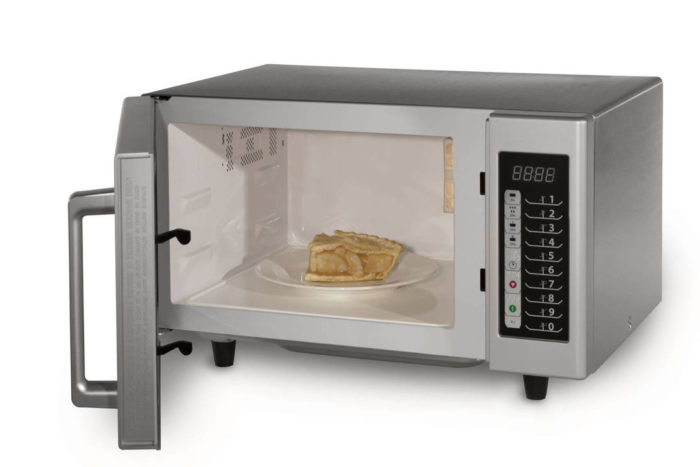
Image Credit: Image #1: ACP MenuMaster
A microwave oven uses less energy than a conventional oven. Even though this statement is broadly true, a microwave oven isn’t always the most efficient way to cook.
So what appliance should you use to heat up or cook your dinner: A gas stovetop? An electric-resistance stovetop? An induction stovetop? A gas oven? An electric oven? A countertop toaster oven? A crockpot? Or a microwave oven?
If all you care about is energy efficiency, it’s possible to come up with an answer to this question — but the answer will depend on the quantity and the type of food you are cooking.
If you care about the taste of your food, on the other hand, energy efficiency probably doesn’t matter. For example, if you are cooking a traditional paella, the answer is, “An open fire fueled by prunings from a vineyard” — and energy efficiency be damned.
Comparing a microwave oven to other cooking methods
A microwave oven uses quite a bit of power — between 950 and 1,720 watts — but it usually isn’t operated for long. According to a 2001 Home Energy article, “the typical residential microwave oven consumes about 110 kWh of electricity per year.” If you are paying 15¢/kWh for electricity, your microwave oven is costing you only about $16 a year to operate.
According to The Consumer Guide to Home Energy Savings, a publication of the American Council for an Energy-Efficient Economy, cooking a casserole costs 16¢ if you use a conventional electric oven; 8¢ if you use a toaster oven; 7¢ if you use a gas oven; 6¢ if you use an electric crockpot; and 3¢ if you use a microwave oven. (These calculations are based on the assumption that natural gas costs 60¢/therm, and electricity costs 8¢/kWh. To bring these estimates roughly in line with current energy prices,…
Weekly Newsletter
Get building science and energy efficiency advice, plus special offers, in your inbox.

This article is only available to GBA Prime Members
Sign up for a free trial and get instant access to this article as well as GBA’s complete library of premium articles and construction details.
Start Free TrialAlready a member? Log in





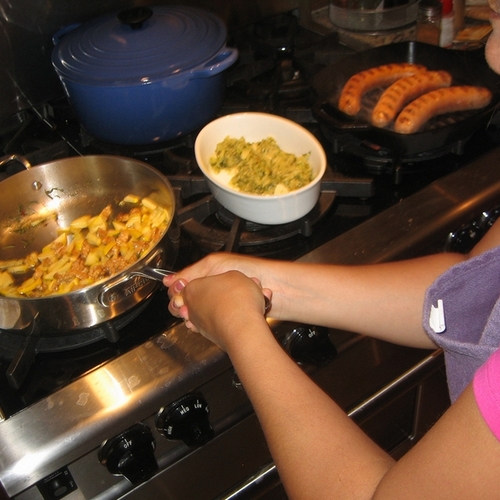
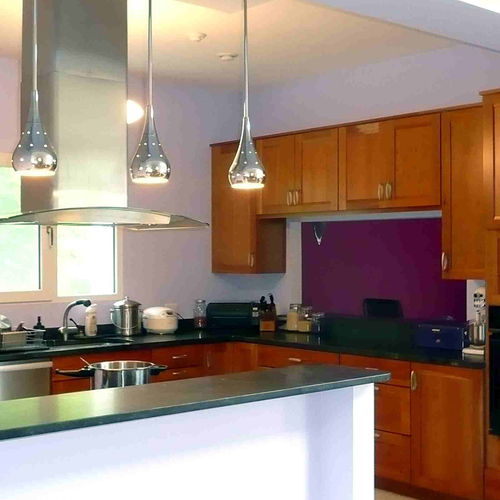
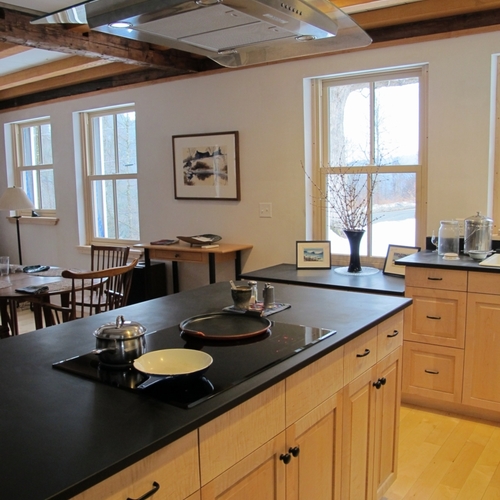
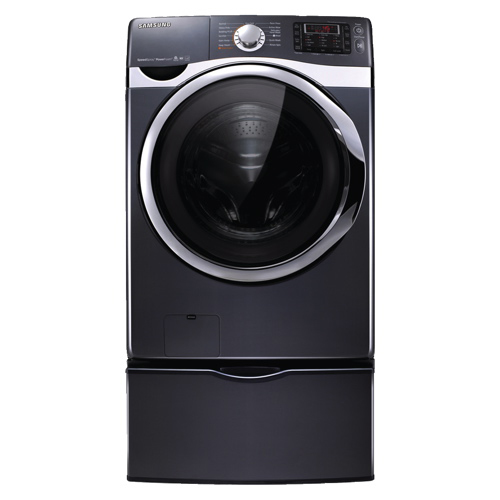






16 Comments
give induction more credit
A cup of water for tea? Induction cooker, hands down. You don't
give them nearly enough credit for energy efficiency. They boil
water faster than the nuke with almost zero stray heat to dissipate
afterward. I would suggest that 1> people chase the linked post
about induction stovetops, and 2> someone should go remove the
spam that landed in the comments under it.
You can get a one-"burner" induction cooktop from Amazon for between
$50 and $100. The one I got, a Tatung TICT-1500TW, even came with
a cheap pot with the right sort of ferrous bottom plate to make it
work, and it happens to be the perfect shape for those "one-skillet"
type dinners or stir-frys if that's what you're into. 1500 - 1800
watts on high for most of them, but you get your oatmeal in 30 seconds.
What you don't get is that little bit of extra winter heating in
your kitchen area, but that's arguably a good thing as that's the
heat pump's job.
_H*
Response to Hobbit
Hobbit,
Thanks for your comments. I have edited the paragraph about Jennifer Mitchell-Jackson's mug-of-tea research to reflect your point.
Thanks also for tipping me off to the spam. It has been deleted.
Kettles
Stand-alone electric kettles should be more efficient than the stove top since there is much less stray heat. I just wish we had 220 wiring like Britain so we could have their fast 3000w kettles.
Since I'm wishing... how about induction ranges or cooktops that don't cost 3-4 times as much as a basic electric range. Hobbit, a single-burner standalone model is fine for some, but my kitchen doesn't really have extra space for one, and it would be obnoxious on top of our existing range (and we might accidentally burn it).
Echo Hobbit
I have a standard soup lunch I consume about twice per week and it takes about 4 minutes to heat in a 1600 Watt drawer microwave, but only 100 seconds using a 1600 Watt single "burner" Burton induction cooker I also got from Amazon for under $100. My only objection to the Burton is that it concentrates all that heat in a six inch disk - continuous stirring is mandatory for the entire 100 seconds.
induction cooking
I also got a cheap single burner induction cooker, primarily so I could try cooking on it before making a decision for our new house cooktop. I am very pleased with how well it works. It makes giving up gas cooking easy, and allows us to avoid the issues with gas in a tight house.
As for cost, induction is definitely more costly, but compared with a high end gas cooktop, a mid-priced induction unit isn't bad, about $1000 or so. I suppose one could calculate the payback period based on gas or electricity saved, but for me, avoiding gas is a big plus.
Response to Curt Kinder and Stephen Sheehy
Curt and Stephen,
Thanks for your comments and measurements. It looks like induction cooktops win the "cup of tea" race.
But you can't bake a potato or easily reheat leftovers with an induction cooktop, so a microwave oven may still have a place in the American kitchen.
microwaves
Martin-I don't think an induction cookbook will replace microwaves, but will eventually replace gas cooking. I still need the nuker for popcorn and leftovers.
Response to Stephen Sheehy
Stephen,
I've always made stovetop popcorn. All you need is a heavy cast aluminum or cast iron pot with a lid.
People made popcorn for hundreds of years before microwave ovens were invented.
popcorn
I've also made it on the stovetop, but since Al Gore invented microwave popcorn, that's my go to method :-)
I wasn't suggesting induction replaces microwave
Each has its place. Nothing beats a microwave to quickly warm a cup of cooled coffee or random leftovers.
I just wish microwave ovens were more efficient.
When I indulge in popcorn, I use a hot air popper and dribble butter onto the stuff as it emerges.
Gas has no place in indoor cooking especially as houses get tighter, but I doubt I'd ever give up my gas grill unless I become a purist as to grilling steaks over charcoal...maybe when I retire and have that kind of time.
kettles and power surges
Electric kettles may be the highly energy efficient, but did you know that they are responsible for power surges in Britain?
http://www2.nationalgrid.com/Media/UK-Press-releases/2014/World-Cup-fans-switched-on-to-Brazil/
According to this dramatic video from the BBC, there are actually engineers standing by to power up auxiliary generating stations at the end of popular TV programs.
http://www.bbc.co.uk/britainfromabove/stories/people/teatimebritain.shtml
(If anyone was interested in the power surges caused by tea kettles, I figured it would be readers of this forum.)
Resistance element more efficient than a microwave?
The claim that using a resistance element to heat water for a cup of tea consumes fewer watts than does a microwave doing the same job is counter intuitive and almost certainly wrong. After you take your tea cup of hot water out of the microwave oven there is almost no perceptible warmth left in the oven. In contrast, after heating a kettle of water on a resistance burner you have a red hot coil of burner metal, a warm stove, and a hot steel tea pot, all of which represent significant wasted energy. How can the resistance burner method possibly match the efficiency of the microwave if the first law of thermodynamics still holds?
@Carl
You are right about the relatively little wasted heat energy within the cavity of the microwave oven after a short heating task.
Your analysis falls short of the mark by failing to consider the whole picture. Within the oven enclosure but not the cooking cavity lies the magnetron, which converts (some) electricity to microwave radiation. It and its associated electronics throw off enough waste heat to require a fan for forced air cooling.
A brief browse (and my own limited data) suggests "wire to water" efficiency of a microwave oven is ~50%, whereas an induction "burner" heating a low thermal mass kettle approaches 90%.
You are correct that a conventional infrared smoothtop range loses energy by heating the resistance element and ceramic smoothtop...this can be minimized by cutting power somewhat before heating task is complete; using residual heat to finish the cooking task.
The laws of physics and thermodynamics are strictly enforced, but one must consider their entire jurisdiction to correctly apply them.
Response to Carl Mezoff
Carl,
You wrote, "The claim that using a resistance element to heat water for a cup of tea consumes fewer watts than does a microwave doing the same job is counterintuitive and almost certainly wrong."
As far as I know, it was not a claim; it was a measurement. For more information on the measurements reported in the Home Energy article, see Cooking with Less Gas.
Response to Curt Kinder
Curt,
Thanks for your very useful explanation of the counterintuitive results that perplexed Carl Mezoff.
Response to Harry Voorhees (Comment #11)
Harry,
Thanks for the links to the articles on spikes in electricity usage in Britain associated with electric kettles.
It's one more example of how the British are more civilized than Americans. When broadcast football games are over in the U.S., viewers go to the kitchen and get another beer. The British brew tea.
Log in or become a member to post a comment.
Sign up Log in